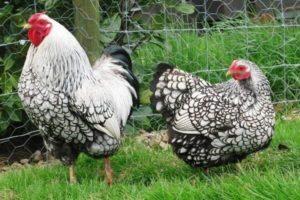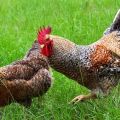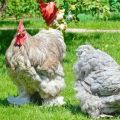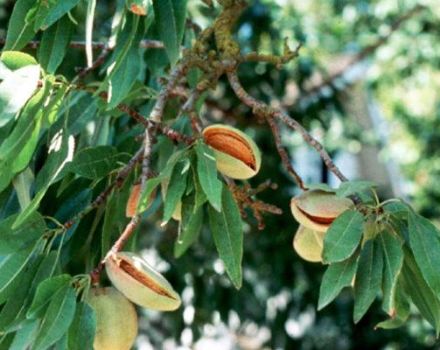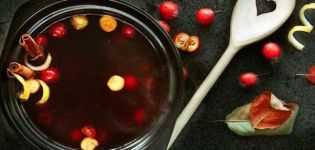Varieties and description of the Orpington chicken breed, maintenance rules
The Orpington pedigree chickens are popular with breeders. Poultry breeders prefer the English breed, as it is considered universal. Adults weigh 5 kilograms and produce up to 180 eggs per year. At the same time, the bird is not too "finicky", it is kept in the chicken coop, and the Orpington's cell keeping is also practiced.
Origin
It all started more than 30 years ago when a breeder from England decided to breed chickens that would meet all the needs of gourmets. William Cook dreamed of white-skinned birds in England.
But it cannot be said that he achieved what he wanted. Kuku managed to breed a breed that was larger, but the characteristics of the individuals were imperfect. After the death of the breeder, the work continued, thanks to bold experiments in crossing various breeds, it was possible to bring out a bird that would meet all the necessary characteristics.
It is believed that it took at least 30 years to breed the breed, but in fact it all started much earlier. Thanks to Cook's efforts, it was possible to obtain "material" for work, after his death, scientists continued experiments, eliminating existing imperfections.
The result of the labors was a versatile breed with impressive size and good egg production.

Description and characteristics of Orpington chickens
According to classical descriptions, the bird meets the following characteristics:
- Has a short neck, straight and wide back, protruding chest.
- The body of the chicken is covered with loose plumage, it has a cuboid shape.
- Due to the large weight and wings pressed against the carcass, which are also short, the bird does not actually fly.
Chickens are smaller when compared to roosters, but the difference is not significant.
Let's talk about the advantages of the breed:
- not demanding in terms of conditions of detention;
- differ in high, but not record, egg production rates;
- not fast, but systematically gaining weight.
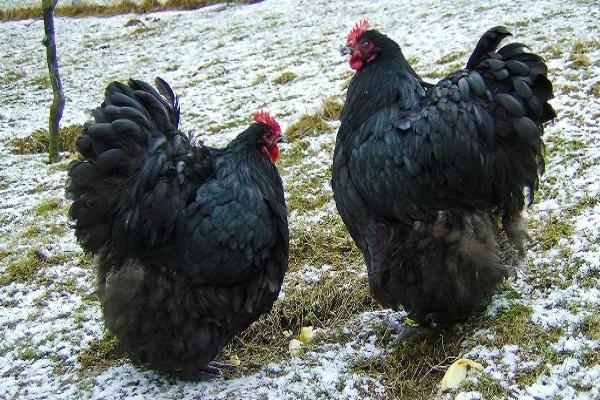
Attention! Breeders note as an advantage the fact that representatives of this species are distinguished by a friendly character. They are phlegmatic, do not show aggression.
Orpington also has disadvantages that should be considered when breeding:
- Chickens are prone to obesity, which affects egg production. Individuals who have gained excess weight reproduce slowly.
- If you do not take care of the chicken coop, do not change the layers of the litter, do not monitor the nutrition of the birds, then they can get sick.
It is worth controlling the portion size in winter, when individuals move little.
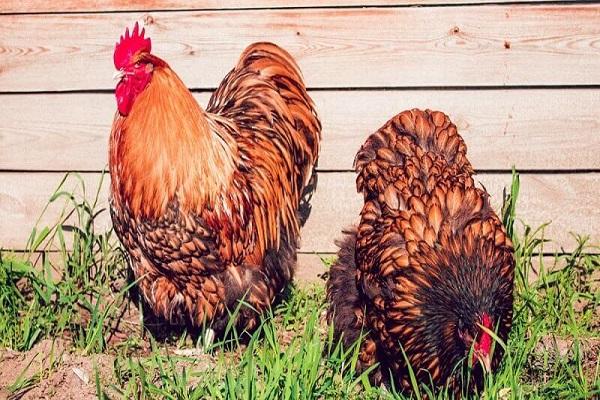
Appearance and varieties
There are about 11 varieties of chickens of this breed. Birds differ in color, but not in behavior.
The black
The rooster, like the chicken, has a dark color, black feathers can have a greenish or even bronze tint. This is the ancestor of the breed, so the standards are strict. Chickens have dark or brown eyes. But the appearance of spots, white tint, red eyes is considered unacceptable.
Black-bordered
The color implies a combination of several colors: brown, black and white. The chicken is golden-black in color. In this case, the chest or belly of the bird is black.
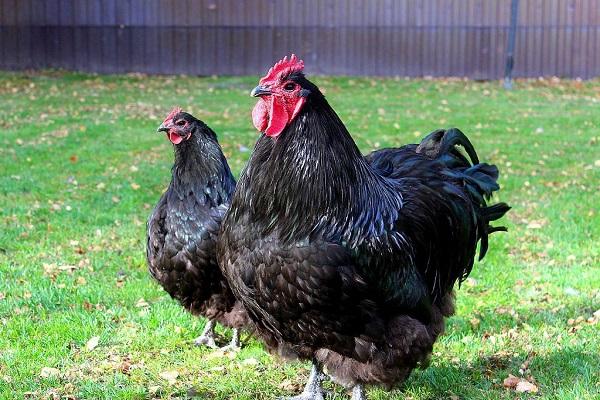
White
A large bird, absolutely snow-white, with the same beak. The eyes are orange. The appearance of spots on the body, a change in the color of the plumage, red eyes are the degeneration of the breed.
Marble
The main color of the color is black, all feathers on the tip end with a spot of white, the coloring is uniform. It resembles a drawing on marble.
Yellow
They appeared in 1894, when they managed to cross the gold-bordered Orpington with the dark Dorkings. Gold, red or fawn color does not affect its egg production, but among poultry farmers it is believed that the bordered Orpington has an increased egg production. He has white skin and a large meat carcass.
Porcelain
The plumage is tricolor, each feather has a "pearl" - a white spot. The eyes of individuals are red-orange, but the beak is white or cream.

Blue
Interesting bird color; blue feathers have dark, black edging. The beak is black or slate. The eyes are brown or dark.
Striped
This color is also called "hawk", because the poultry looks like a hawk. Feathers of two colors, mostly black with a green tint.
Chocolate
Red-brown bird with characteristic white streaks on feathers that merge into stripes. The wings are darker than the neck and tail, the chest is brown.
A bird of any color must be sampled if it has the following characteristics:
- long body;
- legs non-standard in length;
- too long tail with fluffy feathers;
- yellow skin, sunken breast;
- other defects are included in the list.

Breed productivity
Orpington chickens have moderate egg production, which decreases over the years. In the first year of life, a hen lays up to 180 eggs, in the second year, the indicator drops and is 140-150 eggs.
If the bird is obese, then the indicator decreases, but it can be restored if you pay attention to the diet: exclude compound feed, giving preference to sprouted wheat.
The average size of a bird depends on its sex:
- Chickens, on average, weigh no more than 4 kilograms.
- But the roosters reach a mass of 5 kilograms.
Character of chickens
Such birds are phlegmatic, they do not show aggression, they are very friendly towards people.

Conditions of detention and care
To keep birds of this breed, the chicken coop will have to be remodeled to meet the needs of the Orpington.
Chicken coop requirements
By their nature, birds practically do not rise into the air - they are too heavy, and their anatomical structure is special. This means that the poles are placed close to the ground. The ideal option is the shape of the poles in the form of a ladder, along which the chicken can move freely.
Help: you can completely remove the roost by preparing bedding for the chickens.

How to make bedding, recommendations:
- pour lime;
- cover it with straw, hay or dry grass;
- the litter should be as dry as possible.
As soon as it gets wet, the risk of developing diseases of an infectious nature increases significantly. To prevent this from happening, change the top layer of the litter regularly to keep it dry.
In the process of decay, bacteria warm the litter, which allows it to maintain a certain temperature in winter.
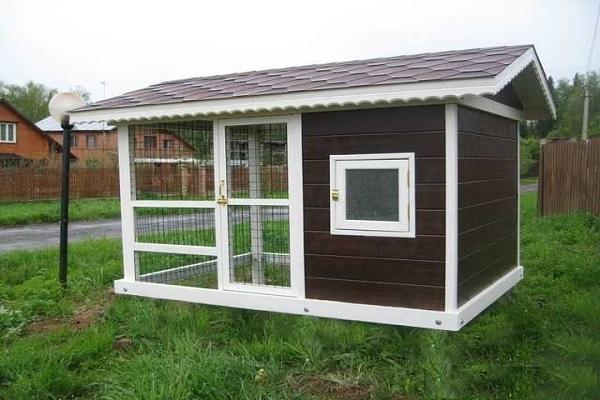
Walking yard
According to the rules, its size is 2-3 times larger than the area of the chicken coop. You can fence off your patio using mesh or other material. It is advisable to prepare something like a pen where the birds will feel comfortable.
Feeders and drinkers
Poultry farmers often make a common mistake when keeping chickens - they pour food on the ground. This leads to increased feed consumption.
It is better to organize feeders, adhering to the following rules:
| For an adult: | a feeder of 10-12 centimeters will be enough. |
| For young animals:
| depending on age, up to 2 weeks - 2-5 centimeters. |
The size of the feeder and drinker depends on the livestock of the chicken coop; it is necessary to provide individuals with free access to food and water.

Diet
If we talk about the fundamental principles, then feeding the Orpingtons is not much different from similar procedures carried out for other chickens. But it is worth considering that representatives of the breed are prone to obesity, so their diet, like the portion size, is regulated.
Chickens
It is worth adhering to the following rules:
- until the age of 2 weeks fed with compound feed;
- on the 3rd day, add a grated chicken egg;
- on the 5th day - boiled millet and corn grits.
On the fifth day, you can give greens: onion feathers, dandelions, young nettles. To prevent protein deficiency - fat-free cottage cheese.

Adults
You can use compound feed, vitamin mixtures. If the bird has significantly gained in weight, then it is "put on a diet" - sprouted wheat is added to the diet, the portion size is reduced.
How to reproduce correctly?
So that they do not mix with other breeds, a separate aviary is being built for the Orpingtons. One or two roosters are left for the winter so that the chickens do not remain alone in the spring.
Chickens of this species are not bad brood hens, but they crush the eggs in the nests due to their large mass. The breeder will have to inspect and clean the nests..
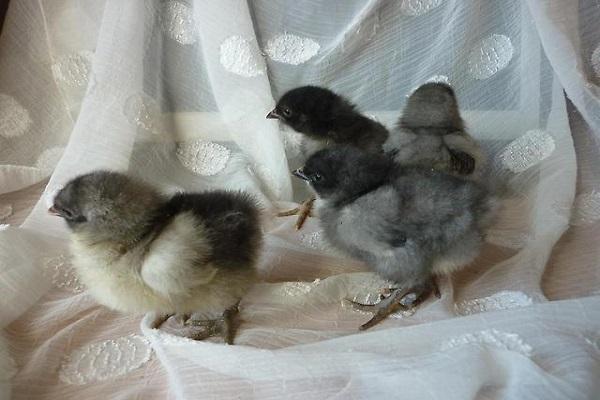
Common diseases
Chickens are distinguished by good immunity, subject to the rules of care, feeding, they rarely get sick. Some diseases are troubling due to lack of vitamins. Also exclude contact of poultry with wild birds, as this can result in the death of the number of layers.
Do not forget that home Orpingtons require vaccinations against diseases:
- Tuberculosis.
- Bird flu.
- Diseases of Marek, Newcastle.

The prospect of breeding Orpington in Russia
In our country, this breed is only gaining popularity. It is much more common in England. The advantages make it promising for breeding, because as a result you can get what you want: meat or eggs.
In addition to productivity, chickens are unpretentious, they do not require special conditions for keeping. However, there is one drawback - it is unlikely that it will be possible to buy chickens and adults cheaply.
English chickens and roosters are considered the best option for keeping them at home. A small livestock of Orpington easily overwinters in a chicken coop, and will bring offspring in the spring. By the fall, the poultry farmer will receive young individuals, which can be left for breeding or used for another purpose.
